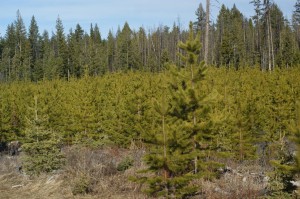- Monocultures
- Ecosystem Resilience
- Forest Fire Resistance
Monocultures:

A Conifer Plantation South of Prince George: Despite the surrounding forest having many aspen and birch, this new plantation has not a single one
“The amount of area that is classified as a monoculture at free growing has increased by 9% on areas harvested since 1987.” – Tree Species Composition and Diversity in British Columbia, Ministry of Forests, 2008, page vii.
“There are more lodgepole stands out there than there used to be and also are encouraging to get rid of this so-called brush, so that’s the aspen, the birch and the cottonwood- so they’re trying to minimize these early successional species so they are simplifying the stands.” Dr. Suzanne Simard, UBC Forest Science Professor, personal conversation, 2011.
Ecosystem Resilience:
“In general, stands appeared to be at increased risk of damage (from disease or insect infestation) where they had been broadcast burned, spaced, brushed (i.e. herbicide sprayed) or pruned.” – Suzanne Simard, W. Jean Mather, Jean L. Heineman, and Donald L. Sachs, Forest Health, in: Silviculture Magazine, Fall 2010, page 28.
“One hypothesis about why mixed stands are often preferable over pure stands is that individual trees of the same species have less root and crown contact in mixed stands than in pure stands, which reduces the possibility of disease transmission. The other general principle is that mixed stands are better able to survive if there is an outbreak of one forest pest specific to only one of the tree species in the stand. Although it has not been fully documented for birch–conifer mixed stands in British Columbia, there are suggestions that some tree species in mixed stands may benefit from damage to other tree species in the stand. In principle, this could be one way that mixed stands provide the best opportunity to sustain woody biomass productivity, as well as overall forest health and biodiversity values.” Paper Birch Manager’s Handbook for British Columbia, BC Ministry of Forests, 1997.
“Risk of damage often increases with spacing, pruning and brushing” Suzanne Simard “The Trouble with Pine.”
“There’s so much wisdespread planting of pine…when you create single species stands when you get something in there that effects pine or spruce the damage can be quite high. Stands that had been recently declared free-growing were no longer free-growing was 30% because of the range of insects that affects lodgepole pine.”Dr. Suzanne Simard, UBC Forest Science Professor, personal conversation, 2011.
“Broadleaves certainly reduce attack rates.”- Dr. Chris Hawkins, former forest science professor at UNBC and current director of research at Yukon College, personal conversation, 2011.
“If you have more species no the site if one species gets hit like lodgepole pine has you’ve got other species there. If you can carry more species on a site it is advantageous.” Craig Delong, former Ministry of Forests Research Ecologist, personal conversation, 2011.
“The other thing they do they keep diseases in check. If you have a mixed stand its more resistant to disease than if you have a pure stand of conifers.” Dr. Suzanne Simard, UBC Forest Science Professor, personal conversation, 2011.
Forest Fire Resistance
“Young stands of conifers are more flammable than older stands. When we create younger, uniform stands you are setting up a landscape that will have a positive feedback to propogating that disturbance across the landscape.”- Dr. Suzanne Simard, UBC Forest Science Professor, personal conversation 2011.
“Aspen climate is cooler and more humid – it’s creating heterogeneity across the landscape that can reduce the spread of fire.”- Dr. Suzanne Simard, UBC Forest Science Professor, personal conversation, 2011.
“Broadleaves are less flammable than conifers. If you have breaks of broadleaves across the landscape they slow the rate of the spread of the fire.”- Dr. Suzanne Simard, UBC Forest Science Professor, personal conversation, 2011.
“Its fair to say if you have tree species A that doesn’t burn very much and tree species B that usually burns a lot- you’re going to have less fire altogether if you don’t separate them spatially.” Dr. Steve Cumming, Canada Research Chair in Boreal Ecosystems Modelling, personal conversation, 2010
“[Monocultures of conifers are] going to increase the risk of burning at least for a couple of decades relative to if you had a mixed stand of pine and aspen.”- Dr. Steve Cumming, Canada Research Chair in Boreal Ecosystems Modelling, personal conversation, 2010.
“I think balance is important. To suppress a relatively fire-resistant species you are potentially creating a mono-fueltype. In my opinion you have to have a mosaic of species. One species will be its own buffer.” Steve Richburg- Forest Protection Officer, Quesnel, Ministry of Forests, personal conversation, 2011.
“The more mosaic of uneven age groups of the species out there- and a big factor would be the aspen in this country [since] it does not have that crown-fire capability- if you could have that in there it would certainly be a benefit. No doubt about it.” – Steve Richburg, Forest Protection Officer, Quesnel, Ministry of Forests, personal conversation, 2011.
“We saw plantations lost [In the Pelican Lake area] because of fuel build-up adjacent to it. Many of the trees were destroyed. We had a major setback out there. Depending on the width of the aspen it would have made a difference. It’s a no brainer that an aspen stand next to or along the perimeter of the plantation [would have made a difference]. [We should] encourage the aspen growth.”- Steve Richburg, Forest Protection Officer, Quesnel, Ministry of Forests, personal conversation, 2011.
